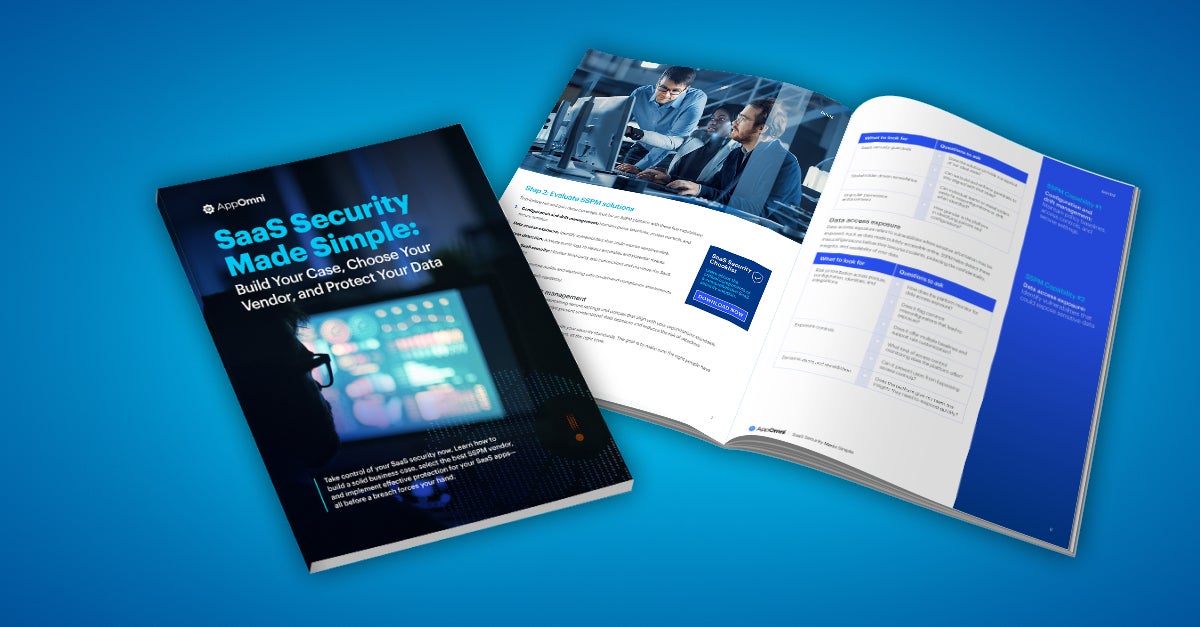To prioritize risk and strengthen your defenses, make sure your SaaS Security Posture Management (SSPM) platform covers these five critical areas: configuration and drift management, data access exposure, threat detection, SaaS-to-SaaS security, and compliance. Use this SaaS security posture checklist to help you assess vendors and bolster your SSPM strategy.
SaaS configuration management
Configuration management is about maintaining secure settings and policies that align with your organization’s standards. By controlling configuration drift, SaaS Security Posture Management (SSPM) helps prevent unintentional SaaS data exposure and reduces the risk of attackers exploiting vulnerabilities.
SSPM platforms reduce drift by aligning settings with your security standards. The goal is to make sure the right people have access to the right resources, with the right permissions, at the right time.
| What to look for | Questions to ask |
|---|---|
| SaaS security guardrails | Does the solution provide a snapshot of our ideal state? Can we build and enforce guardrails to stay aligned with that state? |
| Stakeholder-driven remediation | Can individual teams or stakeholders easily fix misconfigurations or drift when identified? |
| Granular permission enforcement | How granular is the platform in identifying policies and configurations? |
SaaS data exposure
Data access exposure refers to vulnerabilities where sensitive information may be exposed, such as data made publicly accessible online. SSPM helps detect these misconfigurations before they become incidents, protecting the confidentiality, integrity, and availability of your data.
| What to look for | Questions to ask |
|---|---|
| Risk prioritization across posture, configuration, identities, and integrations | How does the platform monitor for data access exposure? Does it flag common misconfigurations that lead to exposure? Does it offer multiple baselines and support rule customization? |
| Exposure controls | What kind of access control monitoring does the platform offer? Can it prevent users from bypassing access controls? |
| Dynamic alerts and remediation | Does the platform give my team the insights they need to respond quickly? |
SaaS threat detection
Threat detection helps identify and analyze suspicious activity across your SaaS apps. SSPM platforms collect and normalize event logs, structure the data for analysis, and apply both standard and custom detection rules to surface anomalies. Once threats are flagged, the platform provides triage guidance to help teams investigate and respond faster.
| What to look for | Questions to ask |
|---|---|
Complete SaaS activity monitoring | Can the platform generate normalized event logs? Are the data model details of those logs clearly documented? |
| Continuous alerting | Can teams configure detections for their specific environment? Can the platform normalize and accurately sequence events from multiple sources, even if they arrive out of order? |
| Application-specific and cross-cloud detections | Does it support both out-of-the-box and custom detection rules? |
| Alert-specific context and guided remediation | Is guided remediation included? Does it provide event JSON, MITRE ATT&CK® mappings, trigger logic, and investigation guidance? Is the detection logic clearly documented? |
| Specificity and depth of detection | Are alerts specific and non-redundant with existing tools? |
| SOC Integrations | Can the platform integrate with SIEM, SOC tools, or data lakes? |
SaaS-to-SaaS security
SaaS-to-SaaS connections—integrations between cloud apps—help businesses streamline operations by sharing data and automating workflows across platforms.
For instance, a CRM might connect to an email marketing tool to trigger campaigns based on user behavior. That email tool is a third-party app. Any apps connected to it are considered fourth-party.
AppOmni research shows that the average enterprise SaaS instance has over 256 SaaS-to-SaaS connections. Shockingly, around 100 of those haven’t been used in the last six months, but they still have access to sensitive data .
Securing third- and fourth-party apps (both sanctioned and unsanctioned) is a critical but often overlooked part of SaaS security. With visibility into these connections, enterprises can better protect their attack surface, reduce data leaks, stay compliant, and manage third-party risk.
| What to look for | Questions to ask |
|---|---|
| Visibility into third- and fourth-party SaaS connections | Am I getting the visibility I need to understand how third- and fourth-party apps affect my SaaS attack surface? |
| Granular insight into app privileges | Can I identify whether a specific app has create, read, update, and delete (CRUD) privileges? |
SaaS compliance
Manual compliance audits for SaaS apps are time-consuming and complex. Every vendor has different configurations, policy models, and log formats. On top of that, new country-specific regulations and new SEC rules for SaaS add pressure to already overburdened compliance teams.
Inconsistent log files make it difficult to investigate events or spot violations. Without SSPM, these tasks become too slow and cumbersome to do on demand.
| What to look for | Questions to ask |
|---|---|
| On-demand compliance assessments and reporting | Can I monitor my SaaS apps by a specific compliance framework? |
| Identification of misconfigurations that lead to noncompliance | Can I generate audit reports for specific services, like Workday? |
| Out-of-the-box policy templates with continuous monitoring | Can I track my compliance status by SaaS over time? |
SaaS security posture made simple
Take control of your SaaS security now. Learn how to build a solid business case, select the best SSPM vendor, and implement effective protection for your SaaS apps—all before a breach forces your hand. Download the full guide today!
SaaS Security Made Simple

Learn how to build a solid business case, select the best SSPM vendor, and implement effective protection for your SaaS apps.
Download eBook: SaaS Security Made Simple: Build Your Case, Choose Your Vendor, and Protect Your Data